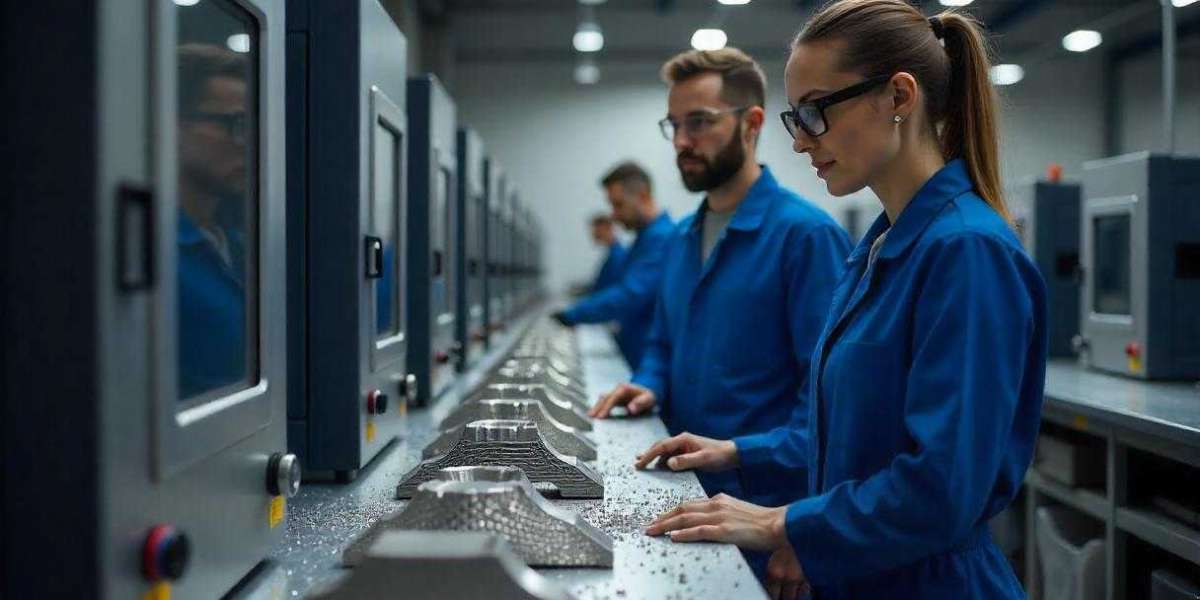The world of manufacturing is experiencing a significant transformation, driven by advancements in 3D printing technology. Among these innovations, Directed Energy Deposition (DED) metal 3D printing has emerged as a game-changer, offering companies the ability to create complex, durable metal parts with unmatched precision. In this blog, we will explore how DED metal 3D printing works and how it’s revolutionizing the manufacturing landscape.
What is Directed Energy Deposition (DED)?
Directed Energy Deposition (DED) is a 3D printing process that uses focused thermal energy to fuse materials by melting them as they are being deposited. In simpler terms, DED allows for the addition of metal material, layer by layer, to build up complex, precise metal parts. This method is unique because it uses an external energy source such as a laser, electron beam, or plasma arc to melt and deposit material directly onto a substrate or existing part.
Unlike traditional manufacturing methods, which often require subtracting material (like machining), DED builds parts up, making it ideal for applications where additive manufacturing offers distinct advantages, such as reduced waste, faster production times, and the ability to create intricate geometries.
Key Features of DED Metal 3D Printing
Versatility in Materials
DED metal 3D printing is highly versatile when it comes to the types of metals that can be used. From stainless steel and titanium to cobalt-chromium alloys and Inconel, the process can handle a wide range of materials suitable for various industries, including aerospace, automotive, and medical.Precision and Accuracy
The precision of DED allows manufacturers to create parts with fine details and complex geometries, making it ideal for industries that require exacting standards and reliability. The high degree of control over the deposition process ensures that each layer of material is added with accuracy.Repair and Maintenance
One of the standout features of DED metal 3D printing is its ability to repair or restore worn-out parts. Instead of replacing expensive components, DED can be used to add material to the damaged areas, extending the life of the part and reducing maintenance costs.On-Demand Production
With DED metal 3D printing, manufacturers can create parts on-demand, minimizing the need for large inventories and reducing lead times. This flexibility is particularly beneficial for custom parts and low-volume production runs.
How DED Metal 3D Printing is Transforming Manufacturing
Aerospace Industry
The aerospace industry is one of the biggest beneficiaries of DED metal 3D printing. The ability to create lightweight, complex, and highly durable parts is crucial for aerospace applications, where performance and safety are paramount. DED allows manufacturers to create components such as turbine blades, fuel nozzles, and heat exchangers with reduced weight, increased strength, and improved thermal performance. Additionally, the ability to repair high-value aerospace parts reduces the overall cost of maintenance and replacement.Automotive Manufacturing
In the automotive sector, DED metal 3D printing offers the potential to produce parts that are not only lighter but also more efficient. For example, DED can be used to create intricate engine components or custom parts for high-performance vehicles, improving fuel efficiency and overall performance. Moreover, manufacturers can quickly adapt their designs for rapid prototyping, reducing product development timelines.Medical Device Manufacturing
The medical industry has also embraced DED metal 3D printing for the production of custom implants, surgical instruments, and prosthetics. The ability to create highly customized, patient-specific components ensures a better fit and more effective treatment. DED’s precision makes it ideal for the production of complex medical devices, offering a level of flexibility that traditional manufacturing processes cannot match.Tooling and Production Equipment
DED is also transforming the way tooling and production equipment are made. The precision of the process allows for the creation of intricate tool designs and custom fixtures that can optimize manufacturing processes, improve product quality, and reduce waste.
Benefits of DED Metal 3D Printing for Manufacturers
Reduced Material Waste
Traditional manufacturing processes often result in material waste due to subtractive methods, where excess material is cut away. DED, on the other hand, is an additive process, meaning material is only used where needed, reducing waste and improving overall material efficiency.Faster Turnaround Time
With DED, the lead time for producing metal parts is significantly shorter compared to traditional methods. This faster production process allows companies to bring products to market more quickly and respond to customer demands with agility.Customization
One of the most exciting aspects of DED metal 3D printing is its ability to create custom parts with precision. Whether it’s for a unique repair, a small batch of customized products, or a one-of-a-kind design, DED can produce parts that are tailored to specific needs.Cost-Effective for Low-Volume Production
Unlike traditional manufacturing methods, which often require expensive molds and tooling, DED metal 3D printing can be more cost-effective for low-volume production. This makes it ideal for industries where custom or small-batch production runs are the norm.
Challenges and Considerations
Despite its many benefits, DED metal 3D printing does come with its own set of challenges. The technology can be expensive due to the high initial investment in equipment and the expertise required to operate it. Additionally, DED parts may require post-processing, such as heat treatment or surface finishing, to achieve the desired material properties and appearance. However, as the technology continues to advance, these challenges are becoming easier to overcome.
Conclusion
Directed Energy Deposition (DED) metal 3D printing is revolutionizing the manufacturing industry by providing innovative solutions for producing complex, high-performance metal parts. From aerospace to automotive, medical, and beyond, DED is opening up new possibilities for manufacturers to reduce waste, improve efficiency, and create customized products with unmatched precision.
For companies looking to leverage DED technology, partnering with a metal additive manufacturing company experienced in this process can ensure the successful integration of DED into their production pipelines. As the demand for additive manufacturing continues to grow, DED is set to play a central role in shaping the future of modern manufacturing.




